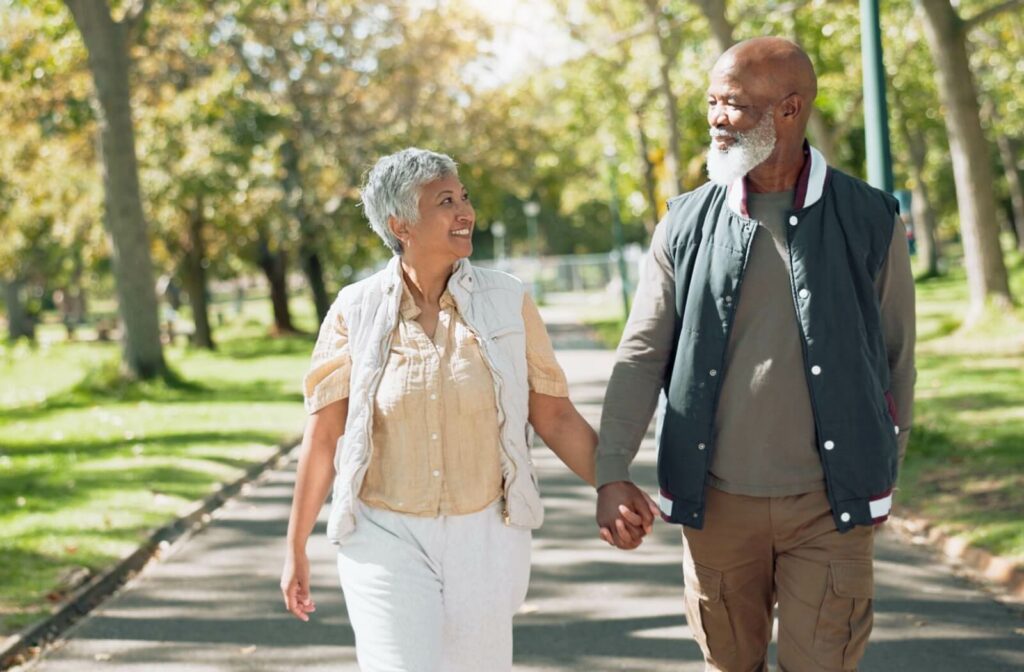Aging brings many changes, but one thing that remains essential is prioritizing regular movement. Staying active is key to living fully, physically and mentally. Walking is one of the simplest and most effective ways older adults can support their health.
Walking supports heart health, helps regulate blood sugar, reduces joint pain, improves balance, and boosts mood. It also helps sleep, strengthens muscles, and encourages social interaction, making it effective for maintaining overall well-being in later life.
Walking doesn’t require equipment, a gym membership, or a schedule. It’s gentle on the joints, adaptable to any ability level, and has an impressive list of health benefits. Understanding how to make walking a daily habit can help seniors move easier and stay more connected.
Why Walking Is One of the Best Exercises for Seniors
Walking stands out as an ideal form of exercise for older adults. It’s low-impact, flexible, and safe—and unlike many other forms of fitness, it doesn’t require a high level of endurance or coordination.
Walking Is Safe & Adaptable
Seniors can walk at their own pace, take breaks when needed, and gradually increase distance over time. It’s one of the few physical activities that can easily adjust to meet changing needs and energy levels.
Walking Requires No Equipment
All you need is a comfortable pair of shoes and a safe walking path. Whether indoors, outdoors, solo, or social, walking is a low-cost way to improve both body and mind.
Physical Benefits of Walking for Seniors
Walking provides a wide range of physical health benefits that support independence and improve quality of life.
Helps Regulate Blood Sugar
As we age, our bodies become more sensitive to blood sugar fluctuations. Walking—especially after meals—encourages muscles to use glucose for energy, helping to stabilize blood sugar and reduce the risk of type 2 diabetes.
Supports Heart Health
Walking helps strengthen the heart and improve circulation. Research shows that walking for at least 30 minutes a day can lower the risk of heart disease and stroke by up to 35%. It can also reduce blood pressure and support healthier cholesterol levels.
Relieves Joint Pain & Improves Mobility
Contrary to common belief, walking can help reduce joint pain and stiffness. Gentle movement increases blood flow, lubricates the joints, and strengthens the muscles that support them.
Low-impact movement can be especially helpful for seniors managing arthritis or recovering from injury.
Mental & Emotional Benefits of Walking
The impact of walking isn’t just physical—regular movement is deeply connected to emotional wellness and mental clarity.
Boosts Mood & Reduces Anxiety
Walking, especially in natural spaces, is proven to reduce symptoms of depression and anxiety. Movement triggers the release of endorphins, the body’s feel-good chemicals. Add more benefits with fresh air, as time outdoors can have a calming and restorative effect.
Promotes Healthier Sleep
Physical activity during the day helps regulate circadian rhythms, making it easier for seniors to fall and stay asleep. Quality sleep, in turn, supports improved energy levels and emotional balance.
Encourages Social Interaction
Walking can be a shared experience. Whether strolling with a friend, chatting with neighbors, or joining a walking group, this activity opens the door to meaningful connection and reduces feelings of isolation.
How Much Should Seniors Walk?
The Centers for Disease Control and Prevention (CDC) recommends that adults over 65 aim for at least 150 minutes of moderate-intensity activity weekly. That’s roughly 30 minutes a day, 5 days a week.
Start Small & Build Up
Not every senior needs to hit 30 minutes on day one. Shorter walks—10 or 15 minutes—done consistently can still offer real benefits. Over time, older adults can extend these sessions as their stamina improves.
Walk at a Comfortable Pace
“Moderate intensity” means breathing a little heavier but still being able to hold a conversation. A brisk pace is ideal, but even a slower stroll counts, especially for those just starting to add daily activity.

Talk to Your Doctor First
Before beginning any new exercise routine, seniors should consult their primary healthcare provider. A doctor can help assess current health conditions, recommend a safe starting point, and identify any limitations or precautions to consider.
Ask About Footwear & Walking Surfaces
Supportive, well-fitted shoes can help prevent falls and foot pain. Seniors should also be mindful of uneven or slippery surfaces and may consider indoor walking during extreme weather for safety.
Warning Signs to Watch For
Though walking is low-impact, overexertion is still possible. Seniors should pay attention to their bodies and avoid pushing too hard.
Common signs of overexertion include:
- Persistent or worsening pain
- Chest discomfort or shortness of breath
- Dizziness or faintness
- Blisters or skin irritation on the feet
If these occur, it’s time to rest and seek medical advice before continuing.
Walking Encourages a More Active Lifestyle
Daily walking creates a ripple effect of healthy habits. Seniors who walk regularly often find themselves more energized, socially engaged, and motivated to participate in other activities. Walking improves balance, builds confidence, and helps maintain independence longer—all without a gym membership.
A Supportive Community Makes It Easier
Access to a safe, comfortable, and encouraging environment is key to whether seniors stick with a walking routine. In a supportive community, walking becomes more than exercise—it becomes a lifestyle.
From accessible paths to walking clubs and social events, the right setting can make daily movement enjoyable and sustainable. Encouragement from staff, friends, and fellow residents adds extra motivation and turns a solo activity into a shared experience.
Discover the Benefits of Walking at Meadowcrest
At Meadowcrest at Middletown, we understand how powerful something as simple as walking can be. That’s why we’ve designed our community to support healthy movement, meaningful connection, and all the little moments that help seniors thrive.
Whether your loved one enjoys quiet morning strolls, social walks with friends, or structured wellness activities, Meadowcrest supports a vibrant, active lifestyle in a safe and welcoming environment.
Schedule a tour today and take the first step toward a healthier, more connected tomorrow.





